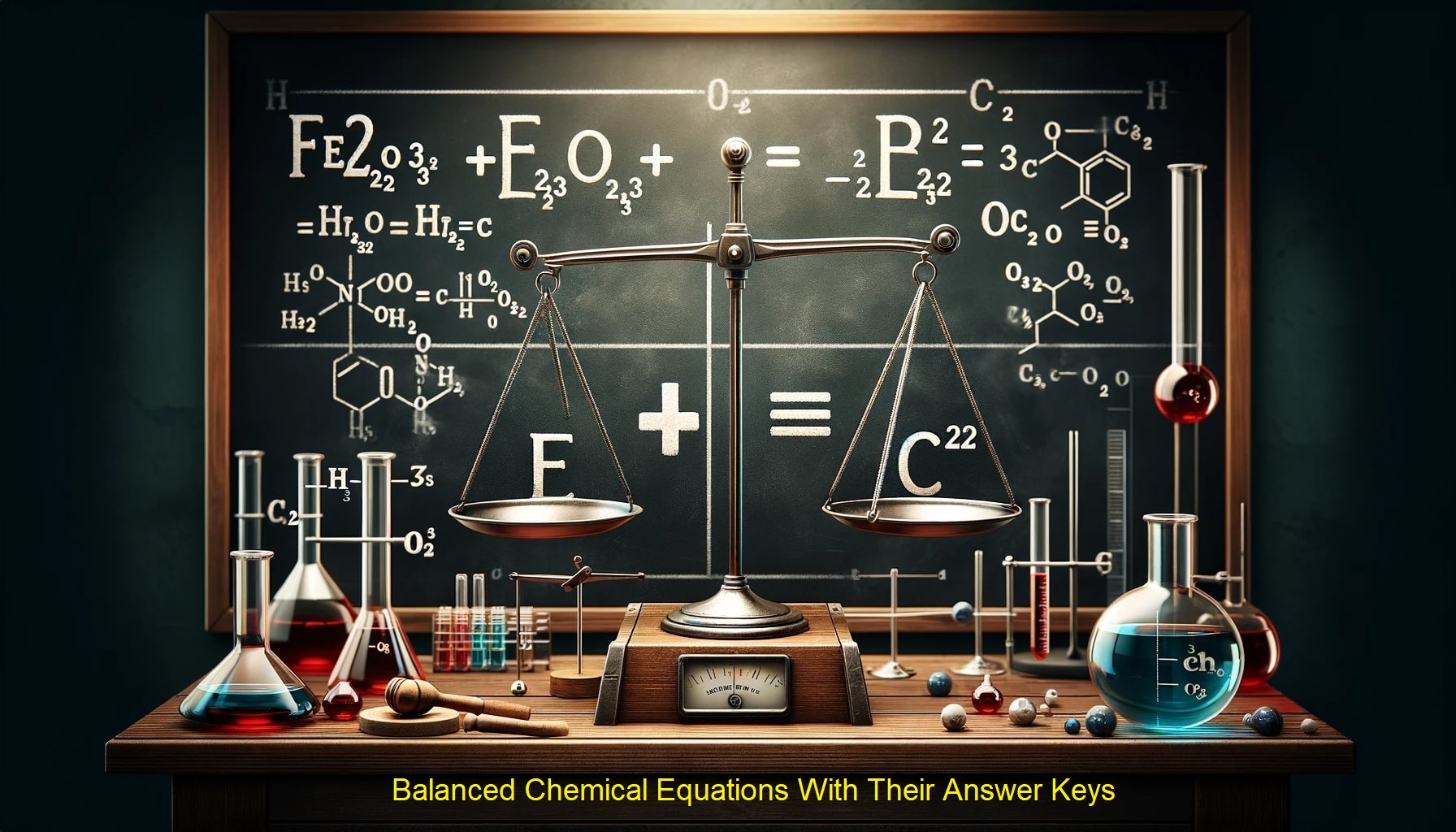
Chemical Equations in Balance. When there are equal numbers of atoms of each element on both sides of the equation and mass conservation, the chemical equation is said to be balanced. Tap this page to find the 50+ Balancing Chemical Equations Answer Key.
The symbolic representation of a chemical reaction using symbols and scientific formulas is called a chemical equation (Source: 01)
Balancing chemical equations is an essential skill in chemistry, ensuring that the law of conservation of mass is upheld in a chemical reaction. In this article, we provide the complete solution, examples, and rations of 50+ Balancing Chemical Equations Answer Key.
Here’s a step-by-step guide to balancing chemical equations:
- Write the Unbalanced Equation: Start with the unbalanced equation, which shows the reactants and products but not necessarily the correct amounts.
- List the Number of Atoms: For each element involved in the reaction, count the number of atoms on both the reactant and product sides.
- Balance One Element at a Time: Adjust the coefficients (the numbers in front of the chemical formulas) to balance the atoms of each element one at a time. Start with an element that appears in only one reactant and one product.
- Balance Polyatomic Ions as a Unit: If a polyatomic ion (like sulfate, SO42−SO42−) appears unchanged on both sides of the equation, balance it as a whole unit instead of balancing sulfur and oxygen separately.
- Balance Hydrogen and Oxygen Last: Since these elements are often in multiple compounds, it’s easier to balance them after the other elements.
- Check Your Work: Ensure that the number of atoms for each element is the same on both sides of the equation.
- Adjust to the Simplest Whole Number Ratios: If necessary, multiply all coefficients by the smallest possible number to convert them into the smallest whole numbers.
Test your skills: Chemistry 10th Class Online Test
Let’s go through an example:
Unbalanced equation: Fe2O3+C→Fe+CO2Fe2O3+C→Fe+CO2
- List the atoms:
- Iron (Fe): 2 on the left, unknown on the right.
- Oxygen (O): 3 on the left, unknown on the right.
- Carbon (C): 1 on the left, unknown on the right.
- Balance one element:
- Balance the carbon by adding a coefficient of 3 in front of CO2CO2 (because there are 3 oxygen atoms on the left side). Now the equation is Fe2O3+C→Fe+3CO2Fe2O3+C→Fe+3CO2.
- Balance the rest:
- Balance iron by placing a coefficient of 2 in front of FeFe on the product side. The equation becomes Fe2O3+C→2Fe+3CO2Fe2O3+C→2Fe+3CO2.
- The equation is now balanced:
- Fe2O3+C→2Fe+3CO2Fe2O3+C→2Fe+3CO2
Here’s a set of 10 balanced chemical equations:
- Combustion of Methane: CH4+2O2→CO2+2H2OCH4+2O2→CO2+2H2O
- Photosynthesis: 6CO2+6H2O→lightC6H12O6+6O26CO2+6H2OlightC6H12O6+6O2
- Rusting of Iron: 4Fe+3O2→2Fe2O34Fe+3O2→2Fe2O3
- Neutralization Reaction (Acid + Base): HCl+NaOH→NaCl+H2OHCl+NaOH→NaCl+H2O
- Decomposition of Water: 2H2O→2H2+O22H2O→2H2+O2
- Haber Process (Ammonia Synthesis): N2+3H2→2NH3N2+3H2→2NH3
- Thermal Decomposition of Calcium Carbonate: CaCO3→CaO+CO2CaCO3→CaO+CO2
- Combustion of Propane: C3H8+5O2→3CO2+4H2OC3H8+5O2→3CO2+4H2O
- Synthesis of Water: 2H2+O2→2H2O2H2+O2→2H2O
- Silver Tarnishing: 4Ag+O2+2H2S→2Ag2S+2H2O4Ag+O2+2H2S→2Ag2S+2H2O
Balancing Chemical Equations Answer Key
- Iron Oxide Reduction: Fe2O3+3C→4Fe+3CO2Fe2O3+3C→4Fe+3CO2 | 1:3:4:3
- Sulfuric Acid and Calcium Carbonate Reaction: H2SO4+CaCO3→CaSO4+H2CO3H2SO4+CaCO3→CaSO4+H2CO3 | 1:1:1:1
- Hydrogen and Oxygen Combustion: 2H2+O2→2H2O2H2+O2→2H2O | 2:1:2
- Esterification of Acetic Acid and Ethanol: CH3COOH+C2H5OH→CH3COOC2H5+H2OCH3COOH+C2H5OH→CH3COOC2H5+H2O | 1:1:1:1
- Silver Nitrate and Lithium Hydroxide Reaction: AgNO3+LiOH→AgOH+LiNO3AgNO3+LiOH→AgOH+LiNO3 | 1:1:1:1
- Methane Combustion: CH4+2O2→CO2+2H2OCH4+2O2→CO2+2H2O | 1:2:1:2
- Tin and Sulfuric Acid Reaction: Sn+2H2SO4→SnSO4+2H2O+SO2Sn+2H2SO4→SnSO4+2H2O+SO2 | 1:2:1:2:1
- Copper Oxide and Sulfuric Acid Reaction: CuO+H2SO4→CuSO4+H2CuO+H2SO4→CuSO4+H2 | 1:1:1:1
- Magnesium Nitride and Water Reaction: Mg3N2+3H2O→3MgO+2NH3Mg3N2+3H2O→3MgO+2NH3 | 1:3:3:2
- Nitrogen and Oxygen Reaction to Form Nitric Oxide: N2+O2→2NON2+O2→2NO | 1:2:2
- Methane and Oxygen Reaction Forming Carbon Monoxide and Water: 2CH4+3O2→2CO+4H2O2CH4+3O2→2CO+4H2O | 2:3:2:4
- Photosynthesis Equation: 6CO2+6H2O→C6H12O6+6O26CO2+6H2O→C6H12O6+6O2 | 6:6:1:6
- Silver Iodide and Sodium Sulfide Reaction: 2AgI+Na2S→Ag2S+2NaI2AgI+Na2S→Ag2S+2NaI | 2:1:1:2
- Barium Nitride and Water Reaction: Ba3N2+6H2O→3Ba(OH)2+2NH3Ba3N2+6H2O→3Ba(OH)2+2NH3 | 1:6:3:2
- Iron Sulfide and Oxygen Reaction: 4FeS+7O2→2Fe2O3+4SO24FeS+7O2→2Fe2O3+4SO2 | 4:7:2:4
- Phosphorus Pentachloride and Water Reaction: PCl5+4H2O→H3PO4+5HClPCl5+4H2O→H3PO4+5HCl | 1:4:1:5
- Calcium Chloride and Sodium Phosphate Reaction: 3CaCl2+2Na3PO4→Ca3(PO4)2+6NaCl3CaCl2+2Na3PO4→Ca3(PO4)2+6NaCl | 3:2:1:6
- Arsenic and Sodium Hydroxide Reaction: 2As+6NaOH→2Na3AsO3+3H22As+6NaOH→2Na3AsO3+3H2 | 2:6:2:3
- Perchloric Acid and Phosphorus Pentoxide Reaction: 12HClO4+P4O10→4H3PO4+6Cl2O712HClO4+P4O10→4H3PO4+6Cl2O7 | 12:1:4:6
- Potassium Chlorate and Phosphorus Reaction: 10KClO3+3P4→3P4O10+10KCl10KClO3+3P4→3P4O10+10KCl | 10:3:3:10
- Tin Dioxide and Hydrogen Reduction: SnO2+2H2→Sn+2H2OSnO2+2H2→Sn+2H2O | 1:2:1:2
- Potassium Hydroxide and Phosphoric Acid Reaction: 3KOH+H3PO4→K3PO4+3H2O3KOH+H3PO4→K3PO4+3H2O | 3:1:1:3
- Mercury(II) Hydroxide and Phosphoric Acid Reaction: 3Hg(OH)2+2H3PO4→Hg3(PO4)2+6H2O3Hg(OH)2+2H3PO4→Hg3(PO4)2+6H2O | 3:2:1:6
- Potassium Nitrate and Carbonic Acid Reaction: 2KNO3+H2CO3→K2CO3+2HNO32KNO3+H2CO3→K2CO3+2HNO3 | 2:1:1:2
- Sodium Phosphate and Hydrochloric Acid Reaction: Na3PO4+3HCl→3NaCl+H3PO4Na3PO4+3HCl→3NaCl+H3PO4 | 1:3:3:1
- Titanium Tetrachloride and Water Reaction: TiCl4+2H2O→TiO2+4HClTiCl4+2H2O→TiO2+4HCl | 1:2:1:4
- Ethanol Combustion: C2H6O+3O2→2CO2+3H2OC2H6O+3O2→2CO2+3H2O | 1:3:2:3
- Ammonia Oxidation to Nitric Oxide: 4NH3+5O2→4NO+6H2O4NH3+5O2→4NO+6H2O | 4:5:4:6
- Boron Tribromide and Nitric Acid Reaction: B2Br6+6HNO3→2B(NO3)3+6HBrB2Br6+6HNO3→2B(NO3)3+6HBr | 1:6:2:6
- Carbon Monoxide and Hydrogen Reaction to Form Octane: 8CO+17H2→C8H18+8H2O8CO+17H2→C8H18+8H2O | 8:17:1:8
- Aluminum Hydroxide and Potassium Aluminum Sulfate Reaction (incomplete equation): 4NH4OH+KAl(SO4)2⋅12H2O→Al(OH)3+2(unknown products)4NH4OH+KAl(SO4)2⋅12H2O→Al(OH)3+2(unknown products) | Incomplete
- Sodium and Water Reaction: 2Na+2H2O→2NaOH+H22Na+2H2O→2NaOH+H2 | 2:2:2:1
- Glucose Decomposition: C6H12O6→6C+6H2OC6H12O6→6C+6H2O | 1:6:6
- Copper Oxide and Sulfuric Acid Reaction (duplicate): CuO+H2SO4→CuSO4+H2OCuO+H2SO4→CuSO4+H2O | 1:1:1:1 (This equation is a duplicate of equation 8)
- Glucose Fermentation (incorrectly written): C6H12O6→2CO2+2C2H5OHC6H12O6→2CO2+2C2H5OH | 1:2:2
- Iron(III) Chloride and Iron(III) Oxide Reaction: FeCl3+Fe2O3→3FeOClFeCl3+Fe2O3→3FeOCl | 1:1:3
- Sodium Chloride and Silver Nitrate Reaction: NaCl+AgNO3→NaNO3+AgClNaCl+AgNO3→NaNO3+AgCl | 1:1:1:1
- Hydrochloric Acid and Ammonia Reaction: HCl+NH3→NH4ClHCl+NH3→NH4Cl | 1:1:1
- Aluminum and Hydrochloric Acid Reaction: 2Al+6HCl→2AlCl3+3H22Al+6HCl→2AlCl3+3H2 | 2:6:2:3
Read more.. FSc Chemistry Part 1 Online Test
